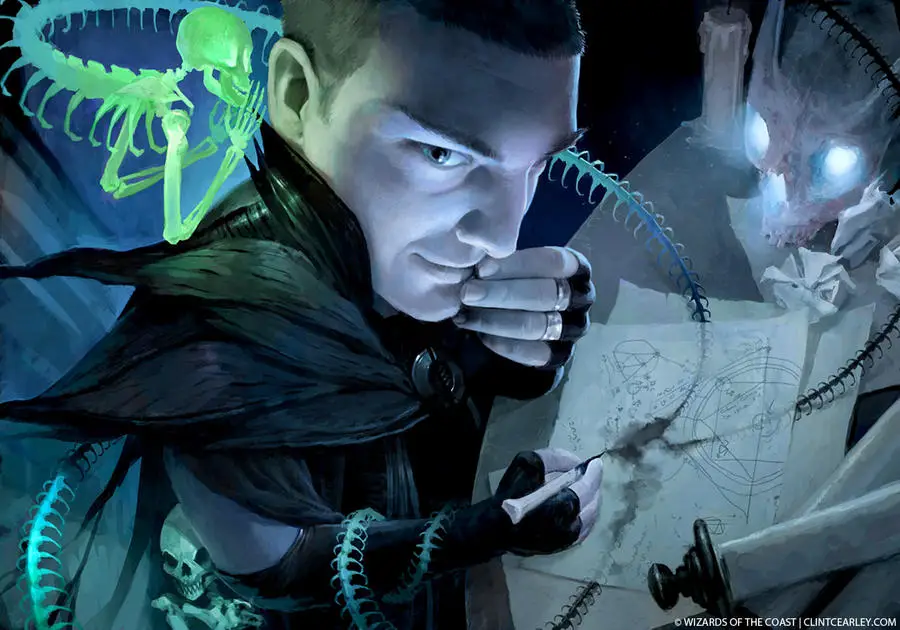While Dissonant Whispers won’t get your Bard any gigs, it will most definitely cause your opponents some terrible pain! With some practice, this spell will even have the weak-minded running for the hills.
Whether you want to go full Yoko Ono on your foes or you prefer a dark and doomy dirge, this is the spell for you.
When cast under the optimum conditions it can also lead to tons of good old-fashioned chaos for your enemies. A spell that can cause damage and cause your enemy to suffer Opportunity Attacks at 1st level! Sign me up!
Dissonant Whispers is an epic spell that proves just how powerful enchantment magic can be. So let’s take a closer look at how it works and how you can use it in your games!
What is Dissonant Whispers in D&D 5e?
Dissonant Whispers is an interesting spell with a very strong Verbal Component to it that encourages lots of flavor.
I’d definitely encourage you to come up with your own flavor for this one as it can really add some extra fun to the game. You might whisper chilling words of madness or a dark and discordant melody meant to inspire fear.
Of course, you might also go the opposite route and have them cursed with hearing awful screaming and babbling nonsense. I mentioned Yoko Ono in the introduction to this article, so enjoy this video to see what I mean.
However you flavor it, only the target of this spell can hear it so have fun with it!
We’ve provided the official spell description from the 5e Player’s Handbook below for reference and clarity.
Dissonant Whispers
LEVEL: 1st level spell
CASTING TIME: 1 Action
RANGE/AREA: 60 feet
COMPONENTS: V
DURATION: Instantaneous
SCHOOL: Enchantment
ATTACK/SAVE: WIS Save
DAMAGE/EFFECT: Psychic damage
You whisper a discordant melody that only one creature of your choice within range can hear, wracking it with terrible pain. The target must make a Wisdom saving throw.
On a failed save, it takes 3d6 psychic damage and must immediately use its reaction, if available, to move as far as its speed allows from you. The creature doesn’t move into obviously dangerous ground, such as a fire or a pit.
On a successful save, the target takes half as much damage and doesn’t have to move away. A deafened creature automatically succeeds on the save.
When you cast this spell using a slot of 2nd level or higher, the damage increases by 1d6 for each slot level above 1st.
What Does Dissonant Whispers Do in D&D 5e?
The Dissonant Whispers spell is a 1st level spell from the School of Enchantment.
Any poor soul within 60 feet of the caster that can hear can be targeted by this terrifying and painful spell. While it only affects a single target, it can lead to sheer chaos on the battlefield though!
The target is allowed a Wisdom saving throw. If successful, they suffer half damage. On a failed save, the unlucky target takes full damage (3d6 psychic) and they must use their reaction to flee as far away from the caster as their movement allows.
When cast using a 2nd level or higher spell slot the damage increases by 1d6 for every level above 1st.
So for example, if cast using a 2nd level spell slot the psychic damage would instead be 4d6.
Who Can Cast Dissonant Whispers?
Obviously, this has Bard written all over it and becomes available starting at 1st level. Is it any wonder this made our list of the Best Bard Spells in D&D 5e?
While Dissonant Whispers is generally exclusively a Bard spell, there are a couple of other ways to get it.
For example, Warlocks of the Great Old One also have this one on their expanded spell list. In their case, it’s definitely less “unsettling music and thoughts” and more “whispers of pure madness.” I have to confess, I have a TON of fun using this spell with my own GOO Warlock.
You might also pick this up (as well as a couple of cantrips) if you take the Magic Initiate feat and choose the Bard spell list.

Tips For Players Using Dissonant Whispers 5e
Dissonant Whispers is a relatively straightforward spell, but there are still some important things to consider when using it.
While the psychic damage is reliable and pretty hefty for such a low-level spell, this is also a great way to ruin enemies’ tactics and formations.
Here are a couple of tips to keep in mind when using Dissonant Whispers!
Target the Weak-Minded
If your Bard or Warlock is able to discern which opponents have below-average Wisdom scores, you should target them. Targeting weak-minded opponents is more likely to trigger them into using their reaction to move away from the caster.
At lower levels, Ogres, Goblins, and Kobolds fit the bill perfectly.
If your enemies have a “big, dumb brute” on their side, this can be incredibly helpful for getting the brute to back off. While you mop up the weaklings, your party isn’t having to also withstand the big enemy’s likely-crushing attacks.
After all, the less punishment you and your friends have to take from an angry Ogre or Hill Giant, the better!
Target those in Melee
Creatures engaged in melee combat make for the best targets for Dissonant Whispers.
Not only does making them run give your team some breathing room, but these enemies are more likely to be vulnerable to attacks of opportunity when this spell makes them run for it.
Additionally, they’ll have to reposition themselves on their next turn which means that you might be able to get them in a corner or some other unfortunate position.
Tips for Dungeon Masters Using Dissonant Whispers 5e
As far as Dissonant Whispers goes for DMs, the same principles for players apply here.
You’ll want to have enemies that cast this spell target PCs that they believe have lower Wisdom scores, especially martial classes. Try to avoid meta-gaming and looking at Wisdom scores, it’s important to treat it from the NPC’s point of view.
As for DMs in control of NPCs that fail their saving throw you want to keep the spell description in mind.
“On a failed save, it takes 3d6 psychic damage and must immediately use its reaction, if available, to move as far as its speed allows from you. The creature doesn’t move into obviously dangerous ground, such as a fire or a pit.”
The creature’s primary goal is to get as far away from the caster as possible and their “escape route” should reflect that.
While they aren’t going to jump into a river of lava to get away, they might accidentally back themselves into a corner or some other unfortunate position. Chalk it up to the panic and the chaos of combat.
Dungeon Masters also want to be mindful of a fleeing NPC’s Wisdom or Intelligence scores. Some adversaries are more apt to stumble into Opportunity Attacks even if they can be avoided.
For example, a Hill Giant isn’t going to be smart/tactical enough to take a route that won’t provoke such opportunity attacks.
But an enemy like a Hobgoblin commander would still be very tactic-minded even while panicked. In that case, the character would attempt to minimize the number of opportunity attacks they’re exposed to while running away.
Is Dissonant Whispers a Good Spell?
Dissonant Whispers is a great spell for low-level to mid-level Bards and can really compliment your Warlock of the Great Old One quite nicely as well, both in flavor and tactics.
This is a seriously useful spell that causes moderate damage and scales quite nicely as your character levels up. However, just keep in mind that higher-level adversaries also usually mean higher Wisdom scores. Not always, but it’s common enough that you’ll want to be mindful of that.
Another real upside to this spell is its ability to cause the target to move further away from the caster.
Controlling the battlefield and opening up opponents to Opportunity Attacks is worth its weight in gold. It also doesn’t hurt to have one less combatant breathing down your neck.
When you also factor in the “damage” it does to your adversaries’ action economy by causing a loss of a reaction, this spell only gets better
The range of 60 feet also ensures your PC won’t have to get up close and personal to crush one’s mind. Heck, opponents can’t even hide from this spell as it’s based on hearing.
Dissonant Whispers is a great spell to have on deck and can be useful in almost any combat scenario. Underestimate it at your own peril!

Dissonant Whispers 5e – Frequently Asked Questions
Before we wrap up, let’s look over some commonly asked questions about the Dissonant Whispers spell.
As always, if you have a question that we haven’t answered in this guide, you can always leave a comment below. We’re happy to help you out!
How Long Does the Reactionary Movement Last?
If a target fails their saving throw they will only use their reaction to flee for that round. When they start their next turn they can act freely.
The opponent is also still vulnerable to further instances of Dissonant Whispers for the remainder of the combat.
Does the Caster Need to Have Line of Sight to Target an Opponent?
No. This spell is based on hearing. However, the caster has to know the opponent exists on the battlefield in order to target them.
So, something like an invisible enemy or one that is hidden could still be affected by this spell. The question is “does your character know that they’re there?”
Maybe the eagle-eyed Ranger noticed an enemy hiding in an ambush, but if they haven’t called it out yet then why would your character think to cast the spell?
Does the Movement Caused by Dissonant Whispers Cause Opportunity Attacks?
Yes. As per the rules found in the Player’s Handbook (pg. 195) the movement involved with Dissonant Whispers can lead to Opportunity Attacks as it’s a reaction.
Does Dissonant Whispers cause Fear or the Frightened condition?
No. The movement brought on by Dissonant Whispers is a unique effect.
While it can be described as fear or being frightened, it’s not specifically creating the Frightened condition.
Conclusion – Dissonant Whispers for D&D 5e
Dissonant Whispers is a really cool and flavorful spell that not only damages enemies and controls the battlefield, but it is also great for roleplaying and flavoring your character.
With an excellent mix of damage, battlefield control, and flavor, it’s an excellent spell that deserves more recognition. I’m not sure if this qualifies as an “underrated spell” necessarily, but it’s definitely one of those “if you know, you know” situations!
Got any fun stories from your own games, tactic ideas, or questions about Dissonant Whispers? Let’s chat in the comments below!
Once again we’d like to wrap up this spell guide by thanking you all for reading and supporting the Tabletop Joab website.
Don’t forget to sign up for the Tabletop Joab newsletter! It’s the best way to get all the latest player guides, DM Tips, news, reviews, and more for D&D 5e right to your inbox!
You can also follow Tabletop Joab on Facebook and Twitter.
If you found this article helpful and want to support the site, you can buy me a coffee here! (It’s not expected, but very appreciated!)









